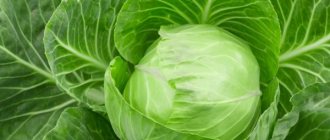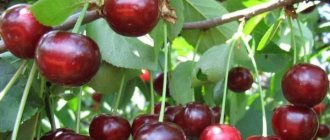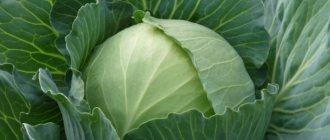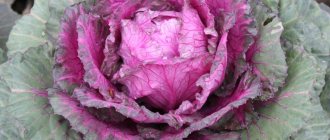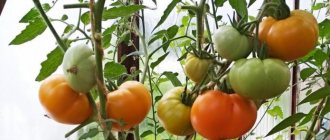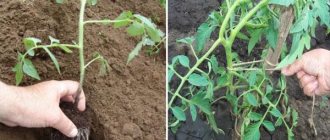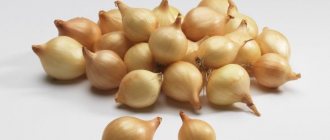Kolya cabbage variety: reviews, photos, description of the variety, features of cultivation and care
Many summer residents necessarily grow white cabbage in their gardens. Late varieties of this vegetable crop are especially popular, since the heads of such vegetables can be stored for long-term storage, salted or fermented.
This article describes the late hybrid Kolya cabbage f1, its main characteristics, advantages and nuances of cultivation.
The content of the article:
History of the variety Kolya cabbage F1: description of the variety Productivity Kolya cabbage Advantages and disadvantages Diseases and pests Kolya cabbage: planting and cultivation Reviews of those who planted the Kolya cabbage variety Description and characteristics from the manufacturer
Characteristics of Kolya cabbage
Kohl's hybrid is resistant to cracking
This hybrid of white cabbage was grown by Dutch breeders. Many farmers and gardeners appreciated all the qualities of the Kohl hybrid. Cabbage appeared in Russia in 2010. Almost immediately it was found that it is resistant to unexpected weather changes, insect pests and many diseases. This cabbage does not require greenhouse conditions.
Description of cabbage Kolya F1: characterized by a rather high stalk (up to 10 cm). Ripe cabbage reaches 23 cm in diameter, and its weight can range from 3 to 8 kg. The leaf blades are not particularly wide. Their edges are slightly wavy and covered with a light coating. The upper surface of the fruit is green with a bluish tint, the inside is white-yellow. Refers to late-ripening crops. The fruits have a solid structure, the leaves adhere well to each other.
History of the variety
This hybrid cabbage variety is the fruit of Dutch selection
. When breeding this hybrid, breeders from the Dutch agricultural company Seminis Vegetable Seeds sought to give it the following positive qualities: high yield, resistance to most diseases, resistance to changing weather conditions.
And they succeeded - Kolya cabbage is one of the best among all late-ripening varieties of this vegetable crop. In Russia, this hybrid can be grown in most regions.
Description and characteristics
Officially, this cabbage species is called Kolya F1, which indicates its hybrid origin. It was bred in the Netherlands by breeders from the seed production company Seminis Vegetable Seeds. The hybrid turned out to have consistently high yields and good tolerance to various climatic conditions, with the exception of severe frosts.
Did you know? The cabbage head is not a fruit at all, but a huge wintering bud sitting on a stem, the role of which is played by the stalk.
Taste and appearance
Hybrid cabbage Kolya F1 has excellent gastronomic qualities. Its taste is equally good both fresh and pickled or after heat treatment. A special feature of this variety is its complete absence of bitterness.
The cabbage head of this hybrid is different:
- round and slightly flattened shape;
- slight waviness of leaves;
- raised leaf rosette;
- weighing up to 8 kg;
- outer light green color;
- white on the cut;
- homogeneity of the internal structure;
- average size of the inner stalk.
Productivity and ripening time
Representing a mid-late white cabbage hybrid, Kolya F1 cabbage ripens within 130–135 days after planting seedlings in the open air. The yield of this cabbage averages 498 c/ha, reaching 652 c/ha under favorable conditions.
Find out how to choose the best cabbage variety to store for the winter.
Variety resistance
The hybrid does not have great frost resistance, but it has a strong immunity that protects it from:
- mucous bacteriosis;
- fusarium;
- vascular bacteriosis;
- thrips.
In addition, Kolya F1 has a very important quality for cabbage, which is the ability of the head of cabbage not to crack.
Cabbage Kolya F1: main characteristics and description of the variety
Hybrid Kolya belongs to the late-ripening varieties - from the moment of seed germination to the harvesting of ripe heads of cabbage, a little more than 4 months pass.
The outer leaves are medium-sized, slightly wavy. And its surface is slightly bubbly with a characteristic waxy coating. The leaf rosette is slightly raised.
Ripe heads of Kolya cabbage have a round, slightly flattened shape
. The color of the outer leaves is soft green; when cut, the color of the head of cabbage is white. The structure of the heads of cabbage is uniform and dense. The stump is medium in size. The weight of ripe forks can range from 4.5 to 7.5 kg, and the diameter is 21-23 cm.
On a note!
Heads of Kolya cabbage reach their greatest juiciness if the roots have suffered light frosts (up to -2-3 degrees Celsius). This cabbage has no bitterness.
Ripe heads of cabbage are not prone to cracking; after ripening, they can remain on the root for quite a long time without losing their presentation and taste. The harvested crop tolerates transportation well at any distance and can be stored for a long period (up to 10 months) in appropriate conditions.
Photo of Kolya cabbage
In addition, the Kolya cabbage variety has high resistance to mucous and vascular bacteriosis, and ripe heads of cabbage are not prone to cracking even when on the root after ripening, which is an undoubted advantage of the variety.
Advantages and disadvantages
Advantages of a hybrid:
- immunity to diseases and pests characteristic of the crop;
- high productivity;
- possibility of mechanical harvesting;
- crack resistance;
- long shelf life and transportability;
- pleasant taste without bitterness;
- possibility of universal use of heads of cabbage;
- ease of care;
- ability to adapt to climatic conditions;
- the possibility of a long stay on the root after ripening.
Among the minor disadvantages is the high external stalk, which necessitates regular hilling.
Difference from other varieties and hybrids
A comparison of Koli f1 with other mid-late ripening hybrids is presented in the table:
| Hybrid | Head shape | Average weight of a head of cabbage, kg | Productivity, c/ha |
| Kolya | Round, slightly flattened | 2-2,5 | 370-498 |
| Avak | Round-flat or rounded | 2-3,1 | 392-609 |
| Aggressor | Round | 2,5-3 | 431-650 |
| Adapter | Round-flat | 1,8-2,3 | 280-342 |
| Barton | Round-flat | 2,2-3 | 451-859 |
| Arrivist | Round | 1,8-2,1 | 397-492 |
Interesting things on the site:
The best varieties of cabbage for pickling and storing for the winter
The best Dutch varieties and hybrids of white cabbage
Advantages of the variety
Experts include the main advantages of the Kolya cabbage variety:
- high immunity to most diseases and pest attacks;
- the heads of cabbage do not crack when ripe;
- the forks are formed strong and dense;
- the harvested Kolya cabbage crop can be stored in appropriate conditions until the beginning of April;
- the taste of ripe forks is completely free of bitterness;
- universal purpose of the harvested crop;
- Kolya cabbage does not require special care.
There are no disadvantages noted in this hybrid. The only thing you need to remember is that this cabbage forms too large an external stump, so you need to regularly hill up the plants, otherwise during the process of ripening the heads of cabbage they may fall onto the ground.
Diseases and pests of cabbage crops
This cabbage hybrid has high immunity to most diseases, so the plants do not require treatment against most diseases
.
But the resistance of Kolya cabbage to pest attacks is not too high, so it can be affected by the following insect pests:
- cabbage fly
, which can cause serious damage to this vegetable crop. The cabbage fly is most active in June - early July, when young seedlings are just being transplanted into open ground, and they can be seriously damaged by the cabbage fly. To protect cabbage, it is treated with a solution of technical chlorophos (80%) or similar preparations. Two treatments with an interval of 7-10 days are enough; - leaf-eating insects
- cabbage aphids, whites, cutworms, moths or bedbugs. A solution of technical chlorophos is especially effective against these insects. Phosfamide can also be used to treat plants. But you can spray the plants only before the forks begin to set.
Cabbage diseases
Kolya cabbage: agricultural technology for growing, planting and caring for the variety
In most Russian regions, this hybrid is grown by seedlings, and the seed material can be planted not only at home in containers, but also in a greenhouse. Planting seeds of this cabbage for seedlings is no different from growing seedlings of other varieties of this vegetable crop.
Before transplanting Kolya cabbage seedlings, you should prepare the beds for this vegetable crop.
. The best place would be a well-lit area that is protected from drafts and gusts of cold winds. The soil should be loose and fairly fertile with slightly acidic or neutral acidity.
Rules for growing cabbage - video from professionals
Before planting, humus or compost and complex mineral fertilizers are added to the soil.
. The distance between neighboring plants should be at least 0.4 m.
Further care for Kolya cabbage consists of timely watering, regular fertilizing, loosening and hilling, while simultaneously removing weeds.
Kohl's cabbage requires regular watering, as this plant requires more moisture than other vegetable crops.
. But you shouldn’t flood the plantings either. During the period of growth of leaf rosettes, watering should be carried out once every 5-7 days. When the heads of cabbage begin to set, the amount of watering should be increased - during this period the soil moisture should be at least 70%. Therefore, you need to ensure that the top layer of soil is constantly moist.
Regular loosening of the soil after watering, improving air access to plant roots
. The first time you should loosen the soil around the cabbage is 12-14 days after transplanting the seedlings to a permanent place. Subsequent loosening is carried out the next day after the next watering.
To prevent the bushes of this cabbage from falling to one side, it is necessary to carry out several hillings per season.
. For the first time, the hilling procedure is carried out a month after planting the seedlings of this vegetable crop in a permanent place in the garden. Next time you can hill up the cabbage 12-14 days after the first hilling.
During the growing period of Kolya cabbage, it needs to be fed at least 4 times. This vegetable crop especially needs nutrients during the period of tying and ripening of forks.
Usually, organic and mineral substances are added alternately to this vegetable plant. From organic matter, it is best to use a solution of cow manure (per kilogram of organic matter - 10 liters of water), or wood ash, 1 glass of which is added to a square area.
And mineral supplements should include preparations containing potassium, phosphorus and nitrogen.
Plant care
As already mentioned, a distinctive feature of Kolya F1 cabbage is its low maintenance requirements. However, to obtain a good harvest and maintain good immunity, it is necessary to follow basic agrotechnical rules.
Irrigation technique
Newly planted seedlings require regular but moderate watering. It is very important to maintain water balance here, preventing both the soil from drying out and moisture stagnation in the root system. Mature cabbage needs more intensive watering. Its frequency depends on weather conditions. In normal weather, the vegetable is watered once every 5–7 days. During the dry period, the frequency of watering increases to an interval of 1 time every 3 days. The optimal soil moisture for cabbage is 70–75%.
Also read about how often to water cabbage.
Water the cabbage only with warm and settled water. To achieve higher vegetable yields, it is fed 4 times during the growing season. Feeding is especially important at the head of cabbage ripening stage. Cabbage is fertilized with organic fertilizers, ash and mineral fertilizers with a predominance of potassium, nitrogen and phosphorus.
Loosening
For the first time, the soil around the seedling is loosened to a depth of 5 cm a week after planting it in open ground. The following loosening is brought to a depth of 8 cm. The soil should be loosened after each rain or watering to prevent the formation of a crust on the ground, which prevents oxygen from reaching the roots.
As already noted, the tall outer stalk of this cabbage is capable of falling to one side under the weight of the head of cabbage. To avoid this, the vegetable must be hilled in a timely manner. The first time this is done 3 weeks after planting the seedlings in open ground. After a couple of weeks, hilling is repeated.
Read more about what to do if the cabbage does not set into a head.
Prevention of diseases and pests
Possessing the ability at the genetic level to resist mucous and vascular bacteriosis, fusarium and pests in the form of thrips, the cabbage hybrid Kolya under unfavorable conditions and violation of agrotechnical rules can be susceptible to the disease:
- black leg;
- clubroot;
- white rot.
The heads of cabbage affected by these diseases are removed, and the rest, to prevent the disease, are treated with colloidal sulfur, as well as Oxyx or Abiga-Pik.
Important! Cabbage should be treated with these substances until the head begins to set. After this, treating the vegetable with toxic substances is strictly prohibited.
Pests also pose a threat to vegetables:
- cabbage fly , which is a dangerous enemy of cabbage seedlings, to prevent the attack of its larvae, vegetables are sprayed with 80% technical dichlorvos or the preparations “Fury”, Nemabakt”, “Iskra-M”;
- leaf-eating pests in the form of the white moth, cutworm, cabbage aphid and bug, which are combated by treating the vegetable with a 0.2% solution of 80% technical chlorophos or “Phosfamide”.
The cabbage fly is the worst enemy of cruciferous garden crops.


